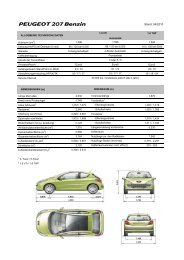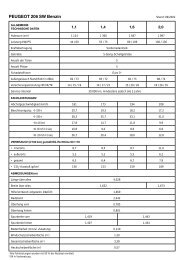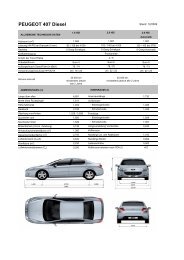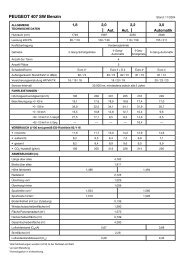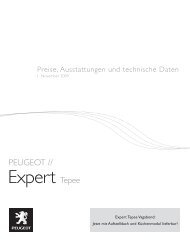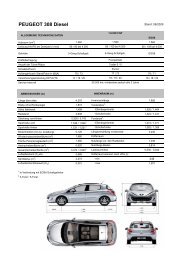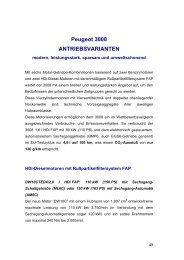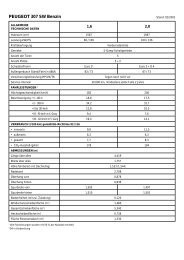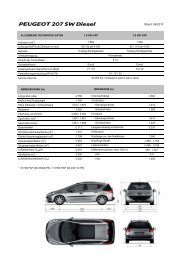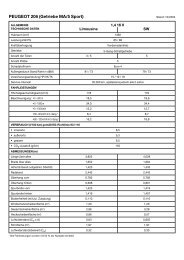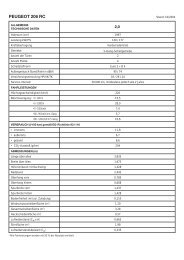PSA COUV page . page RA GB - PEUGEOT Presse
PSA COUV page . page RA GB - PEUGEOT Presse
PSA COUV page . page RA GB - PEUGEOT Presse
Create successful ePaper yourself
Turn your PDF publications into a flip-book with our unique Google optimized e-Paper software.
Growth Strategy<br />
Corporate<br />
Governance<br />
Business Review<br />
Corporate Policies<br />
Management’s<br />
Discussion<br />
and Analysis<br />
Statistics<br />
conditions and to test ABS-equipped<br />
vehicles in actual road conditions.<br />
structural integrity and front-end crumpling<br />
in the event of frontal impact.<br />
• Suspension systems and stiff body shells<br />
A decisive factor in roadholding, metal<br />
suspensions (Peugeot) and electronically<br />
controlled hydraulic suspensions (Citroën)<br />
are two technologies that demonstrate<br />
the Group’s expertise.<br />
The Citroën C5 executive sedan debuted the<br />
new, exclusive Hydractive III electronically<br />
controlled hydraulic suspension system. This<br />
third generation technology has further<br />
improved the balance between guidance to<br />
follow the intended line of travel and filtering<br />
for a more comfortable ride. Smaller vehicles<br />
such as the Citroën C3, feature a rear axle<br />
with deformable crossbeams that ensure<br />
excellent handling in all situations.<br />
Suspension system performance is also<br />
directly related to the stiffness of the<br />
bodywork to which it is attached. The<br />
Group’s body shells rank among the best in<br />
the world in terms of torsional stiffness. This<br />
integrated architecture interacts with the<br />
entire vehicle’s active safety performance.<br />
• Track tests<br />
In 1991, <strong>PSA</strong> Peugeot Citroën became the<br />
first global carmaker to acquire a multigrip<br />
track to simulate winter driving<br />
The Belchamp Test Center in eastern France<br />
recently opened a new roadhandling test<br />
track to help develop vehicles equipped<br />
with electronic stability programs (ESP) and<br />
acceleration skid control (ASR) systems.<br />
The facility simulates different adhesion<br />
conditions on the left and right side of the<br />
vehicle (the cause of a large number of<br />
accidents) using a dry track and a wet<br />
track. The latter has a spray system that<br />
can cover the surface with a sheet of water<br />
between 0.8 and 1 millimeter deep. In this<br />
way, vehicle improvements can be validated<br />
under any road conditions.<br />
PASSIVE SAFETY: STATE-OF-THE ART<br />
PASSENGER PROTECTION SYSTEMS<br />
<strong>PSA</strong> Peugeot Citroën believes that drivers<br />
and passengers are entitled to state-ofthe-art<br />
protection in the event of an<br />
accident, and builds the latest technological<br />
innovations into every one of its vehicles.<br />
• Energy-absorbing front-end<br />
crumple zones<br />
To protect the passenger compartment,<br />
vehicle front ends have to be able to<br />
withstand high-energy impacts. However,<br />
they should also gradually crumple over<br />
the duration of the impact, which lasts<br />
100 milliseconds at most, in order to<br />
dissipate the crash’s kinetic energy and<br />
prevent the occupants from being subjected<br />
to the full force of the sudden deceleration.<br />
Rapid advances in seatbelts and airbags<br />
have also led to a better balance between<br />
The new platform strategy has provided an<br />
opportunity to completely resize the front<br />
ends of small, medium and large models<br />
on the three basic platforms. The Citroën<br />
C3, Citroën C5 and Peugeot 307 were the<br />
first to have their front-end impact strength<br />
doubled and their load resistance tripled<br />
through side beams.<br />
• The passenger compartment,<br />
a survival cell<br />
In an accident, the passenger compartment<br />
can play a critical role as a survival cell.<br />
Architecturally, raising the seat level not<br />
only makes the car roomier and improves<br />
visibility, but also heightens side impact<br />
protection by distancing vital body parts<br />
(head, chest and pelvis) from the impact<br />
area. Higher seats are found in the Citroën<br />
Picasso, the Peugeot 807 and Citroën C8<br />
MPVs, as well as the Peugeot Partner and<br />
Citroën Berlingo mini-MPVs.<br />
The sides of all recent vehicles have been<br />
strengthened by using very high yield<br />
strength sheet metal, which allows the side<br />
body panels to crumple extensively, yet<br />
gradually without ripping apart. Equipping<br />
recent models with side airbags as a standard<br />
option further reduces injury in the event<br />
of side impact. The Peugeot 307, 607 and<br />
807 and the Citroën C5 and C8 also have<br />
side curtain airbags to protect front and<br />
backseat passengers. These advances are<br />
especially important since accidentology<br />
shows that the severity score is greater for<br />
side than for frontal impact accidents.<br />
<strong>PSA</strong> <strong>PEUGEOT</strong> CITROËN - MANAGING BOARD REPORT 83




